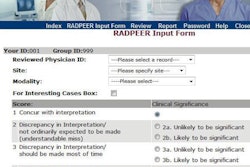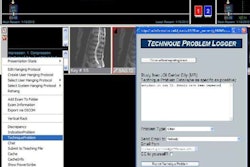The U.S. Centers for Medicare and Medicaid Services (CMS) has released its final rule for stage 2 meaningful use, which now includes the viewing of medical images as a menu item in the U.S. government's healthcare IT stimulus program.
The final rule was published in the August 23 edition of the Federal Register. It follows up on the proposed stage 2 rule released by CMS in February, which contrary to expectations included provisions for medical imaging.
Imaging will be one of six menu objectives for eligible professionals (EPs) in the stage 2 final rule, of which three must be met. There are 17 core objectives, for a total of 20 objectives.
In stage 1, there were 15 core objectives and five (of 10) menu objectives for a total of 20. The final rule also delayed the onset of stage 2 criteria until 2014 to provide needed time for vendors to develop certified electronic health record technology (CEHRT), CMS said.
Notably, CMS has also included a significant hardship exception has applies to radiology.
Final imaging objective
The final imaging objective, "Imaging results consisting of the image itself and any explanation or other accompanying information are accessible through CEHRT," will offer a number of benefits, according to CMS.
"Making the image that results from diagnostic scans and accompanying information accessible through CEHRT increases the utility and efficiency of both the imaging technology and the CEHRT," according to the final rule. "The ability to share the results of imaging scans will likewise improve the efficiency of all healthcare providers and increase their ability to share information with their patients. This will reduce the cost and radiation exposure from tests that are repeated solely because a prior test is not available to the provider."
While electronic data exchange is encouraged to incorporate imaging results into CEHRT, CMS said it also considers it acceptable to manually add the image and accompanying information into electronic records.
In a significant change, CMS modified its proposed measure that more than 40% of all scans and tests ordered by eligible providers be accessible through certified electronic records. After reviewing comments on the measure, CMS revised the threshold to more than 10%.
"Providers, especially EPs, may use many imaging providers, and we do not want an EP to have to defer this objective simply because they have three imaging providers, and the one allowing electronic access represents less than 40% of their orders," according to the rule.
To calculate the percentage, CMS and the Office of the National Coordinator for Health IT (ONC) collaborated to define the following for this measure:
- Denominator: The number of tests whose result is one or more images ordered by the EP or by an authorized provider during the EHR reporting period.
- Numerator: The number of results in the denominator that are accessible through CEHRT.
The resulting percentage must be more than 10% to meet the measure, CMS said. Exclusions include any EP who orders fewer than 100 tests whose result is an image during the EHR reporting period, or any EP who has no access to electronic imaging results at the start of the EHR reporting period.
In addition, some who commented were concerned that standalone radiology centers may not agree to provide their images electronically to providers through their EHR because they are not subject to the EHR Incentive Program, CMS said. As a result, they suggested that it was premature to include this objective.
CMS said it received a number of comments that expressed concern over the cost-prohibitive nature to build out a unique interface for each imaging provider if a health information exchange (HIE) organization did not exist to facilitate imaging exchange.
"We agree that many advances in infrastructure are needed to fully enable this objective," CMS wrote. "We believe that from publication of this final rule to the start of stage 2 significant progress will be made in part due to the inclusion of this objective in stage 2. We do agree that these improvements in infrastructure will vary based on local conditions such as the presence of HIEs, the willingness of radiology centers to link to EHRs, and other factors and note that is a primary reason for this being a menu objective."
CMS did not impose any limitations on the resolution of medical images.
As for a potential second objective measure that would encourage the exchange of imaging and results between providers, most of those who submitted comments agreed that this measure would be premature for stage 2 due to infrastructure concerns.
"Given the comments, we are not including this measure in our final rule," CMS wrote. "We will consider the input provided when we develop our proposal for stage 3."
In another change from the proposed rule, images are now no longer included in the list of required elements for the Stage 2 objective to provide patients with the ability to view online, download, and transmit their health information within four business days of the information being available to the EP.
Commenters had suggested that images should not be included in the list, citing specific difficulties in image viewing online and concerns over file size, CMS said.
"In consideration of the comments received and the complexity and potential burden identified by commenters, we have decided to remove the requirement for images to be available for download and transmission to a third party," ONC said. "We believe further industry dialogue needs to occur with respect to images and our policy goal of enabling patients to have ready, online access to their images. We expect to include this topic on the HITSC's agenda for the next edition of EHR certification criteria we would adopt through rulemaking and intend to propose a requirement for online image access in a future edition of this certification criterion."
Hardship exception
Importantly, CMS also included a significant hardship exception that applies to radiologists. Due to the lack of face-to-face involvement with patients and lack of need to follow-up with patients, a five-year exception is available to EPs that have a primary specialty listed in the Provider Enrollment Chain and Ownership System (PECOS) as anesthesiology, radiology, or pathology six months prior to the payment adjustment year.
EPs would have to demonstrate either a complete lack of face-to-face interactions and follow-up or that cases of face-to-face interaction and follow-up are extremely rare and not part of normal scope of practice for that EP to receive the hardship exception.
CMS noted, however, that the exemption is subject to annual renewal and that specialties should not expect that this exception will continue indefinitely, nor should they expect that we will grant the exception for the full five-year period.
The agency said it will consider the extent to which these specialties continue to face these barriers in the Stage 3 rule and in other future rulemaking, and would also work to develop strategies to assist physicians who lack face-to-face interactions and the need to follow-up with patients in demonstrating meaningful use. Such strategies may be developed in the context of future rules or in the form of additional guidance to physicians in these specialties, CMS said.
"We also encourage all anesthesiologists, radiologists, and pathologists to continue to build out their ability to participate in health information exchange, adopt CEHRT and apply for the Medicare or Medicaid EHR incentives," CMS wrote. "Those seeking the Medicare EHR incentives can start through 2014, while those seeking the Medicaid EHR incentives can start through 2016."




















